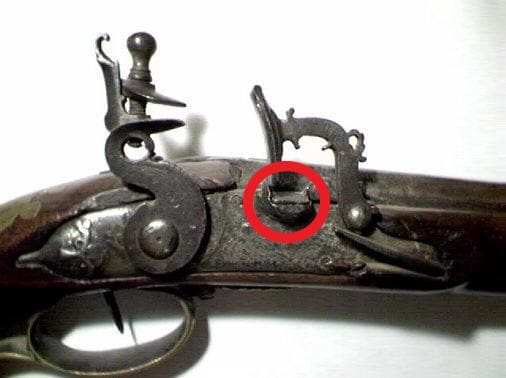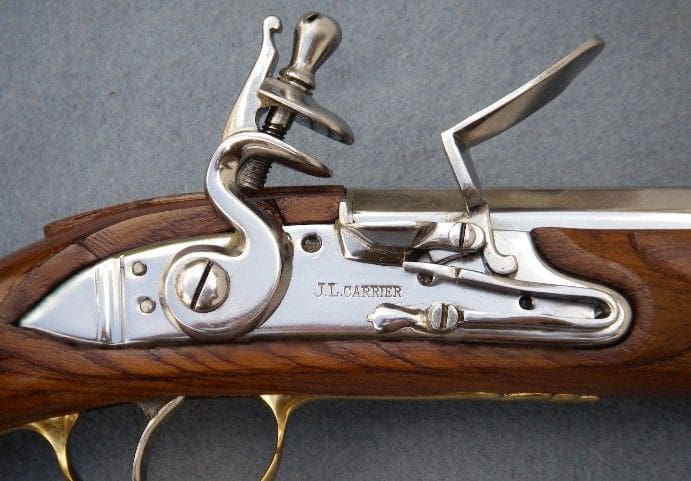Believe it or not, “flintlock” is actually a catch-all term for a variety of different lock mechanisms, in addition to being a specific lock mechanism itself. It’s kind of like “Q-Tip” and “cotton swab.”
Lock mechanisms were undergoing a transformation in the 1500s and 1600s. New designs came on the scene and replaced old ones. Inevitably, there were some “transitional” mechanisms – like the doglock. Appearing around 1630 or so, the doglock mechanism is one of a handful of designs that fits under the flintlock umbrella. Differing from the earlier snaphaunce (or snaphance) locks, the frizzen and the pan cover are part of the same unit. When the frizzen is struck by the flint, the pan is automatically opened, the sparks fall into the pan, the powder ignites, and the firearm is discharged.
Snaphaunce mechanisms featured a separate frizzen and pan cover, which allowed the cover to act at the safety. Even if the hammer were to fall and hit the frizzen, the gun would not fire because the priming powder would still be covered. In this photo, you can see that the flash pan, circled in red, is protected by a cover that is separate from the frizzen:  The doglock, with its integrated frizzen and pan cover, did not have a half-cock sear, just like the snaphaunce before it. Therefore, a new piece of equipment had to be added to the lock to act as a safety. Enter the dog. Why was it called a dog? I guess if you close one eye and squint with the other, it kind of looks like a dog’s ear? The dog was a simple hook that attached to the rear of the lock plate behind the hammer. The hook fit into a notch in the hammer, which prevented it from falling if the trigger were to be pulled. Pulling the hammer back just a tad more would cause some slack between the hammer and the dog, allowing it to be swung out of the way so that the hammer could fall and ignite the powder charge. The dog is visible in the photo below. Note that it has been swung up, but it is not able to engage the notch in the hammer because the hammer has not been pulled back far enough.
The doglock, with its integrated frizzen and pan cover, did not have a half-cock sear, just like the snaphaunce before it. Therefore, a new piece of equipment had to be added to the lock to act as a safety. Enter the dog. Why was it called a dog? I guess if you close one eye and squint with the other, it kind of looks like a dog’s ear? The dog was a simple hook that attached to the rear of the lock plate behind the hammer. The hook fit into a notch in the hammer, which prevented it from falling if the trigger were to be pulled. Pulling the hammer back just a tad more would cause some slack between the hammer and the dog, allowing it to be swung out of the way so that the hammer could fall and ignite the powder charge. The dog is visible in the photo below. Note that it has been swung up, but it is not able to engage the notch in the hammer because the hammer has not been pulled back far enough.  By 1680 or so, the doglock had fallen out of favor in Europe and was being replaced by the true flintlock design. Nonetheless, it hung around for a few more decades and even longer in the American Colonies, where trends and technology were always playing catch-up to their European cousins.
By 1680 or so, the doglock had fallen out of favor in Europe and was being replaced by the true flintlock design. Nonetheless, it hung around for a few more decades and even longer in the American Colonies, where trends and technology were always playing catch-up to their European cousins.
Logan Metesh is a firearms historian and consultant who runs High Caliber History LLC. Click here for a free 3-page download with tips about caring for your antique and collectible firearms.





It seem to me that several of these mechanisms would increase the rate of fire. Therefore banned under the “threat-making crazy known-wolf shot up a school, so let’s DACA(*) authority we didn’t have to ban gizmos that weren’t involved anyway.”
In other news, California is introducing a “tag and track” requirement on people they don’t like, because they, too had nothing to do with the crisis that let’s not waste.
Conveniently, the last administration gave us a new verb, “to DACA”, as in after asserting for years that you don’t have the authoritah to do something, you do it anyway when there’s enough political expediency. I’d expect that to be captured by the lovely folks at Merrian-Websters, being a slang term in common-ish use, because of course they don’t have an agenda, leading to adopting words that reflect well on their peeps & while rejecting those that don’t.
See also: “To Merrian-Webster”, and “King of Nerd Prom.’
Well we aren’t playing catch up on arms, we are playing catch-up with the urapee’en gun laws.
And then, just in time for the war of independence, along comes the Furgeson Rifle.
Thankfully for us, it was expensive, and took a while to produce.
And the breech loading rifle was born.
From Wikipedia: “In engineering, a dog is a tool or part of a tool that prevents movement or imparts movement by offering physical obstruction or engagement of some kind.” Perhaps that would explain why it was called a dog lock?
The dog on the lock prevents the cock (hammer) from moving (falling) just as its canine namesake prevents escape of man or animal by catching hold of the leg, preventing movement.
Aye, me mateys, dog the hatches and prepare for battle!
Loved the write-up. I learned bunches of good stuff.
In crane terminology we say “dog everything” when we want all the brakes set. I suspect they have similar origin.
That one rifle sure looks like it was electroplated, yet that wasn’t invented until 1805. What gives?
elbow grease and some polish.
That is also not an actual antique, its a modern replica made in India.
Wont be long now, that these type of firearms will be the only ones were allowed to own. Till the next demand arises. Oh wait, maybe not. After all they were military grade……..
A flintlock is a specific kind of lock first designed in France not strictly a grouping of related locks that all used flint or chert to create sparks, but I suppose technically they are all locks that use flints, and people outside of arms collecting often lump them together. The group of related locks that generally preceded but were also produced along side the “true flintlock” such as dog locks, miquelet locks, etc. are often collectively known as “snap locks.”
Comments are closed.